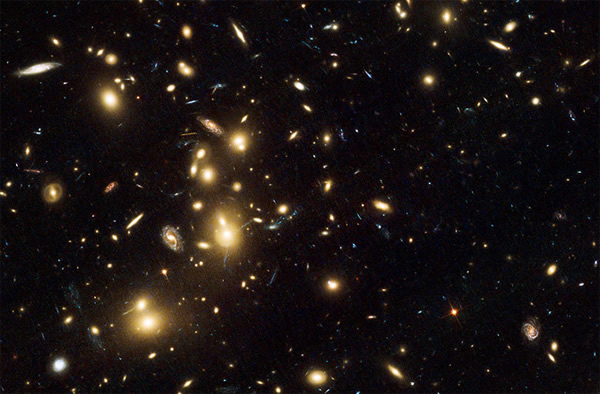Frontier Fields: Hubble Lens to Get Superboost
The galactic cluster Abell 2744 is one of the Frontier Fields targets (and will be the first to be studied) where Hubble will use the lensing effect caused by galactic clusters to boost its magnifying power.
Hoping to get a sneak peak at the early universe NASA’s James Webb Space Telescope is expected to reveal, astronomers are attempting to boost the imaging prowess of the Hubble Space Telescope by taking advantage of naturally occurring zoom lenses in space.
The three-year Hubble Frontier Fields project will make use of the light-bending gravity of six massive galaxy clusters to probe for dimmer, more distant objects behind them.
“You put a bunch of mass in the way of some distant galaxies and it actually magnifies them and makes them easier to see,” astronomer Steven Finkelstein, with University of Texas at Austin, told Discovery News.
It’s a bit of a fishing expedition since astronomers have only vague (if any) hints of what lies beyond the six galaxy clusters selected as targets for the study.
The clusters were selected in part because they lie within viewing range of the Atacama Large Millimeter/submilliter Array, or ALMA, observatory in Chile, the Keck Observatory in Hawaii and other telescopes that will be needed to confirm any objects uncovered by the Hubble probe.
Working with nature’s gravitational lenses isn’t easy, however.
“You don’t automatically know when you look at a galaxy that’s been magnified how much it’s magnified by,” astronomer Jennifer Lotz, with the Space Telescope Science Institute in Baltimore, told Discovery News.
“You have to understand what that cluster is doing. You have to understand the optics of the natural telescope, which means you have to have a model of what’s going on in the cluster, how massive it is, and so forth. We’ve done that,” Lotz said.
The gravitational lenses should at least triple Hubble’s imaging powers. In some cases, it could bring objects into view that are 10 times beyond what Hubble can see.
“Over most of the fields that we are looking at, galaxies will appear three or four times brighter than they are intrinsically. And there will be smaller regions where they’ll appear 10 times brighter and a subset of galaxies will appear 100 times brighter,” Lotz said.
The first 50-hour observing period, encompassing 70 orbits of Hubble over six weeks, is scheduled to begin on Friday. The target is a cluster known as Abell 2744, also known as Pandora's Cluster, which appears to be a galactic pileup of four smaller galaxy clusters that merged some 350 million years ago.(Oct 24, 2013 02:18 PM ET // by Irene Klotz)












